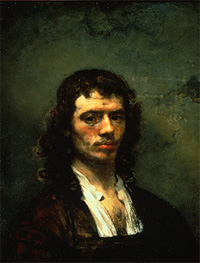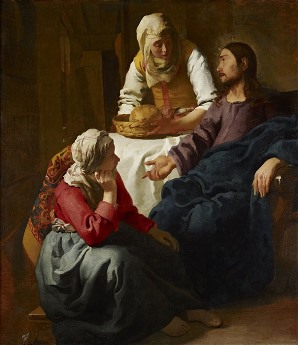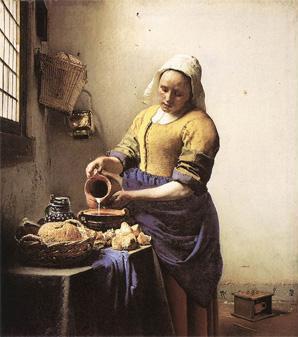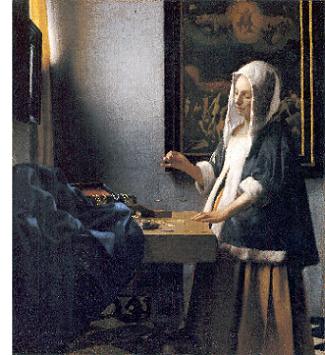Girl With A Pearl Earring.
JAN VERMEER 1632-1675

Girl with a Pearl Earring: Johannes Vermeer, circa 1665-1675.
( The girl portrayed in this tronie's believed to be the artist's daughter Maria).

About the artist.
Girl With A Pearl Earring, a biography about Johannes Vermeer.
Johannes Vermeer's thought to have been born in 1632 in Delft in the Netherlands and baptised, according to records on October 31st. 1632. His father was Reynier Janszoon Vos, but he later used the name, Van der Meer. He was a silk weaver and art dealer. His mother was Digna Baltens who came from Antwerp.
He was their second born and only son and its thought that it was his father who may have had contact with other artists such as Balthasar van der Ast, Pieter Steenwyck, and Pieter Anthonisz van Groenewegen who first introduced him to art. The family owned a large inn called the Mechelen named after the Belgium town.
Little's known about his painting background but its believed that in 1632 he served a 6-year apprenticeship. Part of it most likely being under the Dutch painters Carel Fabritius or Leonaert Bramer.
In 1652 his father died and he inherited the inn where he and his family lived for some time. He also inherited his father's art dealing business.
Girl with a Pearl Earring: The master painter.
In 1653 he enrolled as a master painter at the guild of Saint Luke of Delft where his father had also been a member. Also around the same time he married Catherina Bolnes, from Gouda, who came from a wealthier background than him. The marriage took place in Schipluiden and Leonaert Bramer was a witness at the wedding. Catherina was a Catholic, which resulted in Vermeer changing his religion to Catholicism shortly before their marriage. This also resulted in him giving all his 15 children Catholic names. Four of them died at a very young age, and none carried the name of either of his parents.
Christ in the House of Mary and Martha.
 In 1654 he painted Christ in the House of Mary and Martha (c.1654-1655), this along with Diana and Her Companions (c.1655-1656) and two lost works (The Visit to the Tomb and Jupiter, Venus and Mercury) is thought to be some of his earliest work. He usually preferred to paint scenes depicting everyday life, with a particular attention to detail. Especially when it came to lighting which always came from the left in the form of a window. Examples of which can be seen in, Soldier and a Laughing Girl (c.1658), The Glass of Wine (c.1658-1660). The Milkmaid. (c.1658-1660), Woman and Two Men (c.1659-1660), Woman with a Water Jug (c.1664-1665).
In 1654 he painted Christ in the House of Mary and Martha (c.1654-1655), this along with Diana and Her Companions (c.1655-1656) and two lost works (The Visit to the Tomb and Jupiter, Venus and Mercury) is thought to be some of his earliest work. He usually preferred to paint scenes depicting everyday life, with a particular attention to detail. Especially when it came to lighting which always came from the left in the form of a window. Examples of which can be seen in, Soldier and a Laughing Girl (c.1658), The Glass of Wine (c.1658-1660). The Milkmaid. (c.1658-1660), Woman and Two Men (c.1659-1660), Woman with a Water Jug (c.1664-1665).
Girl with a Pearl Earring: Vermeer's brilliant use of light.
He paid particular attention to the way the light would hit objects and illuminate them and was a master at doing so.  A brilliant example of this is Girl With a Pearl Earring (c.1665). The light catches her lips and earring immediately drawing your attention to them. Although some of his earlier work contained biblical or mythological scenes Vermeer usually painted scenes containing woman. Generally going about their everyday business or scenes containing women in love, women writing letters or playing musical instruments. He preferred to work using a cooler palette containing mainly Blues, Yellows and greys. Going on most of his surviving works, of which there is about 35 his later works also suggest this. It is to this period that his Townscapes belong.
A brilliant example of this is Girl With a Pearl Earring (c.1665). The light catches her lips and earring immediately drawing your attention to them. Although some of his earlier work contained biblical or mythological scenes Vermeer usually painted scenes containing woman. Generally going about their everyday business or scenes containing women in love, women writing letters or playing musical instruments. He preferred to work using a cooler palette containing mainly Blues, Yellows and greys. Going on most of his surviving works, of which there is about 35 his later works also suggest this. It is to this period that his Townscapes belong.
Vermeer's status becomes elevated.
In 1655 Vermeer appears to be gaining an elevated social status as both he and his wife have to sign a document before notary rota to guarantee a debt of 250 guilders that his father had contracted. The appearance of Sr. on the document seems to support this theory.
In 1656 he finally pays the remaining 1.5 guilders master fee to St Luke's Guild. Being that at the time he's unable to pay the full 6 guilders required when he became a member back in 1653. Being that his father's already a member its only required that he would have had to pay 3 guilders but its thought that he served his apprenticeship outside of Delft and so had to pay the full 6 guilders. He also signs his painting The Procuress. He is 24yrs old.
 Sometime after his marriage to Catherina the family left the Mechelen and moved in with Catherina's mother, Maria Thins in Oude Langendijk, she was considered to be a wealthy divorcee. Its thought that throughout Vermeer's career its her who helped finance his work and support the family. Evidence found in the records of the guild of master painters suggested that Vermeer was experiencing financial difficulties. Being Jesuit, they named one of their children, their first daughter after her. Jesuit also seemed to have a big influence on their lives. This included the naming of their other children. Of which one was named Ignatius after the founding saint of the Jesuit Order.
Sometime after his marriage to Catherina the family left the Mechelen and moved in with Catherina's mother, Maria Thins in Oude Langendijk, she was considered to be a wealthy divorcee. Its thought that throughout Vermeer's career its her who helped finance his work and support the family. Evidence found in the records of the guild of master painters suggested that Vermeer was experiencing financial difficulties. Being Jesuit, they named one of their children, their first daughter after her. Jesuit also seemed to have a big influence on their lives. This included the naming of their other children. Of which one was named Ignatius after the founding saint of the Jesuit Order.
Pieter van Ruijven a wealthy member of the community whom it has been suggested may have had an influence on Vermeer's art, became his patron and purchased at least twenty-one of his works. However Vermeer relied largely on his business as an art dealer for his income.
The Guild of Master Craftsmen.
In 1662 and 1663 Vermeer becomes elected president of the guild of master craftsmen and served 4 terms on its board of governor's
In 1670 and 1671 he again becomes elected president of the guild.
1671-1672 Vermeer along with other headmen are called to the Hague. They're required to judge the authenticity of various paintings, sold as works by important Italian masters. He, along with other headmen, judged them as fakes and deemed them practically worthless.
In 1672 following the French invasion of the Netherlands the demand for Art fell into decline. This of course resulted in Financial difficulties for him as he could no longer sustain an income from his work or business and started to borrow money in order to support his large family.
Girl With A Pearl Earring: Death of a master.
In 1675 aged 43 Jan Vermeer died. Its said that his wife had described it as a result and owing to the great burden of his children, having no means of his own, he had lapsed into such decay and decadence, which he had so taken to heart that, as if he had fallen into a frenzy, in a day or day and a half had gone from being healthy to being dead.